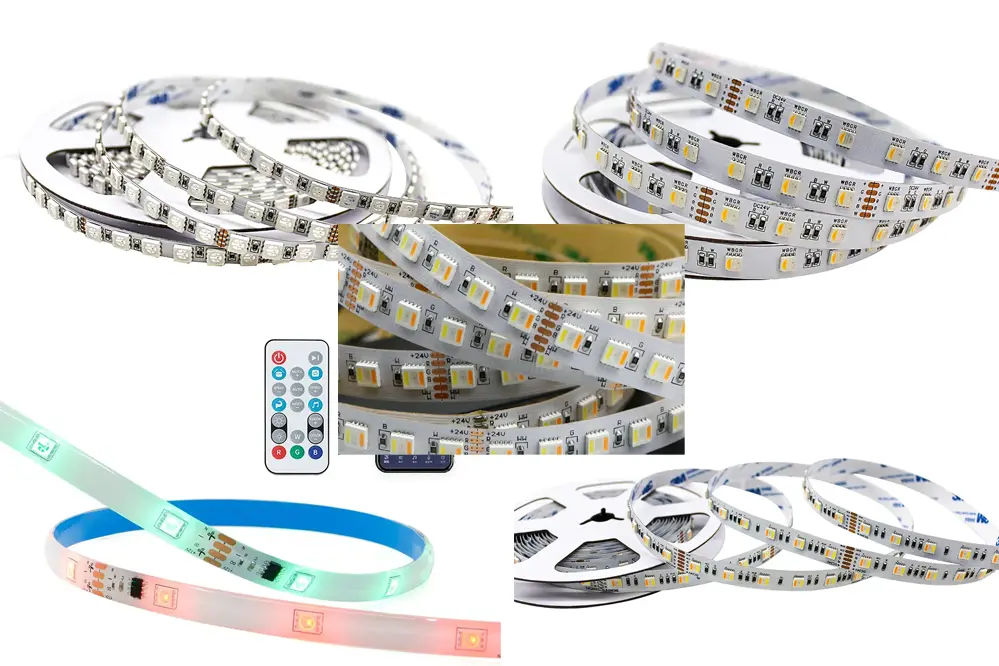In the ever-evolving world of lighting technology, LED strip lights have emerged as a versatile and dynamic solution for both residential and commercial spaces. With a myriad of options available, it can be challenging to navigate the differences between RGB, RGBW, RGBIC, RGBWW, and RGBCCT LED strip lights. Each type offers unique features and benefits, making it essential to understand their distinctions to make an informed decision. In this blog post, we will delve into the specifics of these LED strip lights, shedding light on their capabilities and applications.
As lighting enthusiasts and professionals, we recognize the importance of selecting the right LED strip lights to achieve the desired ambiance and functionality. Whether you’re looking to create a vibrant, colorful display or a warm, inviting atmosphere, understanding the nuances between RGB, RGBW, RGBIC, RGBWW, and RGBCCT LED strip lights is crucial. This comprehensive guide aims to demystify these options, providing you with the knowledge needed to enhance your lighting projects.
Allow me to introduce myself—I’m Tom, a seasoned expert in the LED lighting industry since 2005. Over the years, I’ve amassed extensive knowledge and experience in LED lighting technology, with a particular focus on LED strip lights. My passion for this field has driven me to develop this blog post, drawing from my professional journey and insights to offer you valuable information. My goal is to help you navigate the complexities of LED strip lights and make informed choices for your lighting needs.
So, if you’re ready to explore the fascinating world of LED strip lights and discover which type best suits your requirements, let’s dive right in!
Understanding LED Strip Light Types
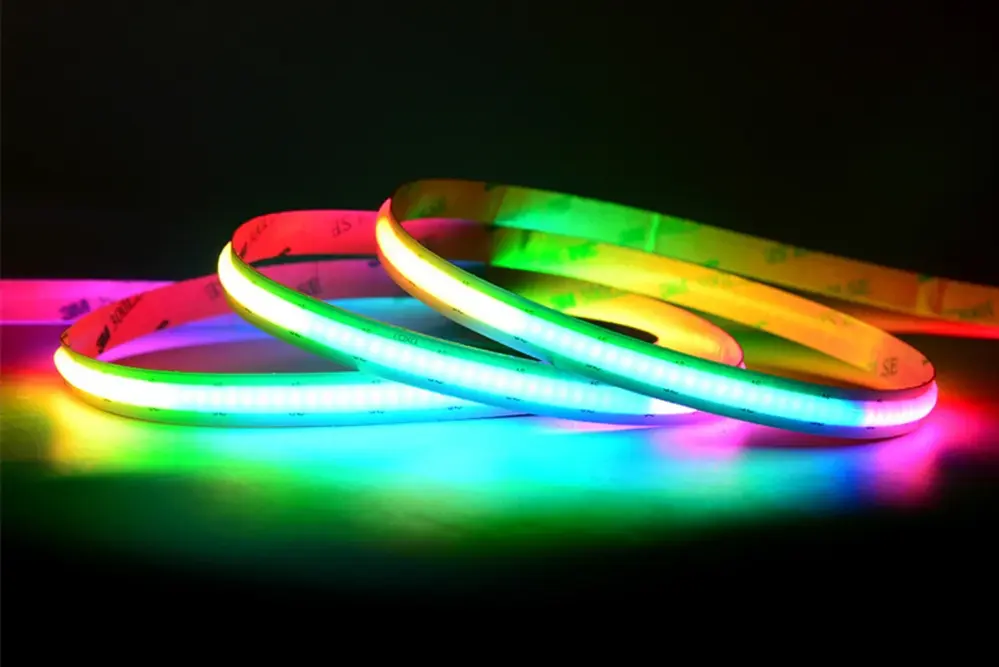
LED strip lights emerge as versatile lighting solutions.
These innovative lights fall into five main categories: RGB, RGBW, RGBIC, RGBWW, and RGBCCT. Each of these classifications brings its own set of capabilities to the table, allowing users to tailor their lighting experience precisely to their needs. Consequently, grasping the essential features of each type becomes pivotal for anyone seeking to make the most informed decision.
RGB strip lights boast vibrant color displays, measured in lumens to indicate their brightness levels.
RGBW and RGBCW add a remarkable white light to the spectrum – an advantage when one desires a blend of dynamic entertainment and functional lighting in their environment.
RGBCCT enriches this experience by enabling the adjustment of color temperature, offering unparalleled customization for any ambiance. Delving into these varieties unveils the expansive possibilities modern lighting technology offers, encouraging anyone to transform their spaces with elegance and efficiency.
What Are RGB LED Strip Lights?
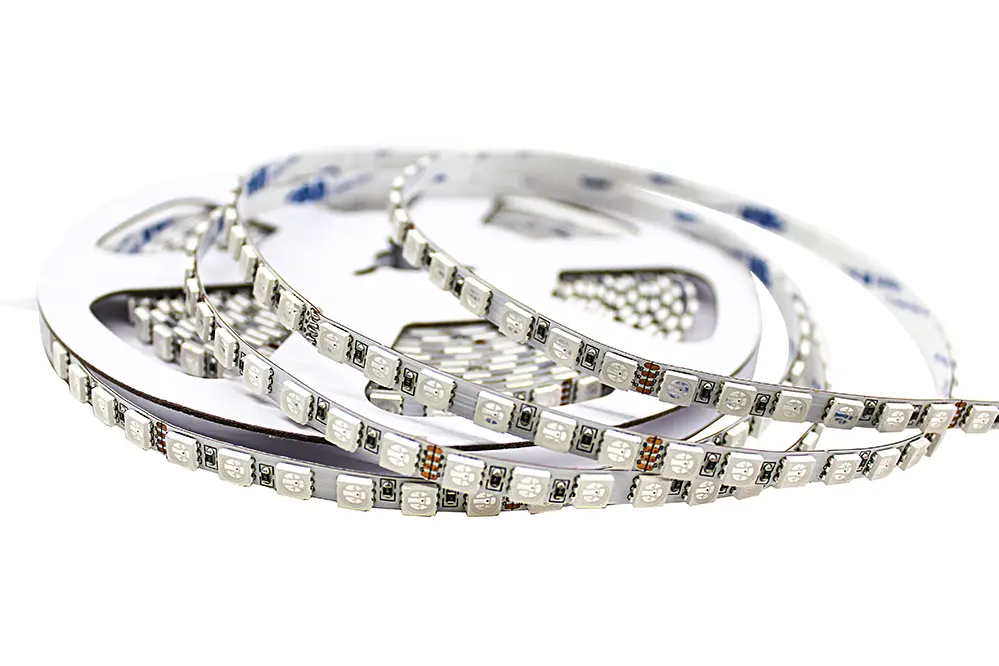
RGB stands for Red, Green, and Blue.
These LED strip lights utilize a combination of red, green, and blue LEDs to generate a wide spectrum of colors. By adjusting the intensity of each color individually, they can create virtually any hue. Consequently, they offer an incredible realm of customization, making them an ideal choice for enhancing the ambiance of various environments. Enthusiasts often turn to RGB strip lights to redefine the aesthetic of their homes with vivid creativity.
The colors can be mixed effortlessly.
Their simple installation process further enhances their appeal. With adhesive backing and straightforward connection methods, users can easily implement impressive lighting solutions.
They seek a balance between practicality and aesthetic pleasure, ensuring that functional lighting can also be part of a visually breathtaking display.
RGB LED strip lights not only provide an extensive palette of hues but also serve as a testament to the seamless integration of technology and artistry. As modern lighting solutions evolve, RGB strip lights remain a cornerstone, bridging the realm of innovation and design.
Benefits of RGB LED Strips
RGB LED strip lights offer a versatile and vibrant lighting solution, perfect for any space.
Since 2016, RGB LED technology has become increasingly sophisticated, enabling users to create environments that genuinely reflect their personality and style. The innovation in this field has been nothing short of remarkable, continually pushing the boundaries of what is possible with lighting design.
Currently, it is not just their color variety that captures one’s attention; RGB LED strips are also valued for their energy efficiency. They consume less electricity compared to traditional lighting options while delivering superior brightness and a longer lifespan.
Furthermore, the user-friendly nature of RGB LED strips makes them accessible to both tech aficionados and beginners. Whether they are looking to set the mood in a cozy living room or electrify a commercial space, the ease of customization and control is second to none.
The combination of aesthetic flexibility and practicality allows RGB LED strips to stand out as a premier choice in modern lighting solutions.
What Are RGBW LED Strip Lights?
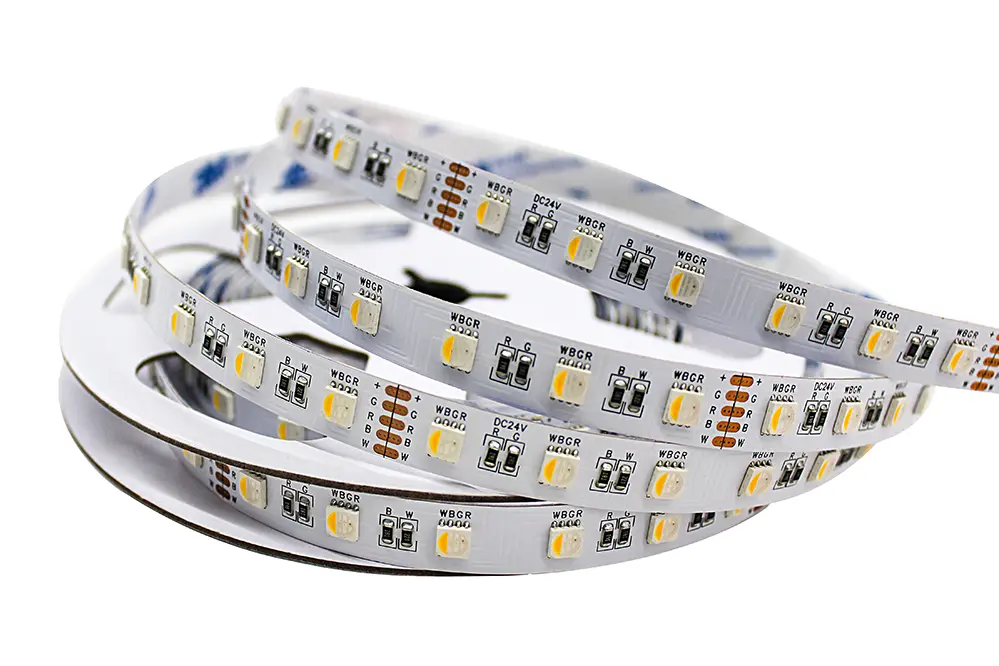
RGBW LED strip lights add white to the mix.
These sophisticated lights offer more than just a colorful spectacle. By integrating a dedicated white LED within the strip, RGBW lights have the unique advantage of providing superior illumination, which can be crucial for areas that need brighter light. Consequently, these lights are not only essential for creating vibrant hues but also versatile in enhancing everyday lighting needs.
Their appeal is broader than the vibrant RGB counterparts.
Users can switch from dazzling colors to a crisp, clean white – an option that significantly boosts the functionality of any space – from enhancing workspaces to fostering serene, ambient settings.
When exploring RGB vs RGBW vs RGBIC vs RGBWW vs RGBCCT LED strip lights, the RGBW variety stands out for its dual-purpose capability, ensuring that homes, offices, and other environments are both visually captivating and practically illuminated.
Advantages of RGBW Strips
RGBW LED strip lights excel in offering versatility beyond mere aesthetics.
For instance, the additional white LED in RGBW strips provides a cleaner, whiter light output compared to traditional RGB strips. This is particularly beneficial in environments where optimal lighting is essential, such as workspaces, offices, and kitchens. The enhanced white light improves clarity and reduces eye strain, making these strips an ideal choice for both professional and personal settings.
Aesthetically, the superior color rendering of RGBW strips allows for more precise and vibrant color displays. It enhances the ambiance of any room, creating atmospheres that range from energetic and lively to calm and soothing. The availability of a pure white light amidst a spectrum of colors broadens the creative possibilities in interior décor considerably.
Functionally, RGBW strips offer energy efficiency and longer lifespan compared to older lighting technologies. This makes them not only a sustainable choice but also an economically savvy investment. Users will find the durability and low maintenance of these lights beneficial in the long run, providing consistent and high-quality illumination for years to come.
Differences Between RGB and RGBW
In the realm of LED strip lighting, the distinction between RGB and RGBW is pivotal. RGB, consisting of red, green, and blue LEDs, offers a versatile color palette.
RGBW includes an additional white LED, enhancing the variety of hues displayed.
This extra white LED in RGBW strips results in clearer, more vivid white light, an essential for many applications.
Unlike RGB strips, RGBW is capable of achieving true white light without color mixing, offering greater clarity.
Furthermore, RGBW strips are particularly advantageous in settings requiring both vibrant colored lighting and a pure white light source. This combination is ideal for various professional and casual environments.
Ultimately, embracing RGBW over RGB translates to more comprehensive lighting solutions. Such versatility allows users to create more dynamic and multifaceted lighting designs.
What Are RGBIC LED Strip Lights?
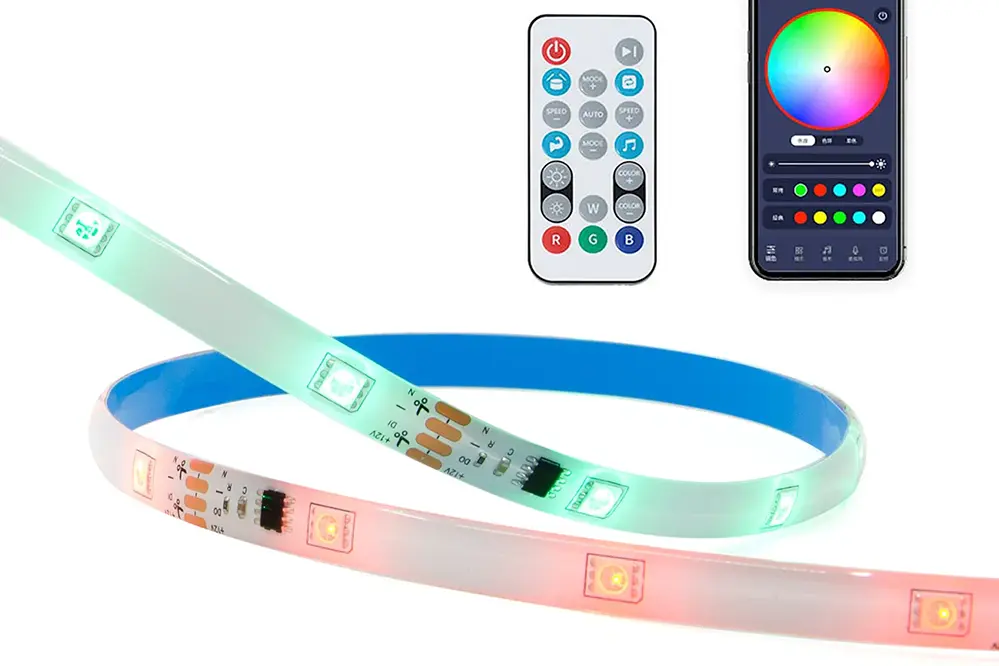
RGBIC LED strip lights represent an innovative leap in the realm of advanced lighting technology.
Introduced around 2016, these lights integrate an independent IC (Integrated Circuit) to achieve intricate and vibrant color patterns. This IC allows for multiple colors to be displayed simultaneously, offering an unparalleled visual experience.
This feature sets RGBIC strips apart from their standard RGB counterparts, which can only display one color at a time. As a result, users of RGBIC lights can enjoy more dynamic and fluid color effects.
Whether enhancing the ambiance of a living space, creating a festive atmosphere, or adding a modern touch to retail displays, RGBIC LED strips are a transformative choice. The addition of an IC provides endless customization possibilities and elevates the artistic potential of lighting design.
Embracing RGBIC LED strip lights ensures a captivating, multi-hued brilliance that exceeds conventional limitations.
Benefits of RGBIC Strips
RGBIC strips offer an exceptional array of lighting possibilities, thanks to their integrated IC technology.
Since 2016, these strips have revolutionized the lighting industry by providing dynamic, multi-colored displays. The integration of the IC allows for distinct segments to show different colors simultaneously.
This feature significantly enhances their versatility, making them ideal for both residential and commercial applications. Users can effortlessly create stunning visual effects tailored to any environment.
Moreover, the ease of customization empowers users to program intricate light sequences, reflecting a spectrum of moods. This unparalleled flexibility fosters creative expression, transforming ordinary spaces into extraordinary experiences.
In embracing RGBIC strips, one finds a blend of innovation and artistry, ready to illuminate and inspire.
RGB vs RGBW vs RGBIC LED Strip Lights
Exploring the various options available, the distinction among RGB, RGBW, and RGBIC LED strip lights is crucial.
In essence, RGB LED strip lights feature red, green, and blue diodes, enabling a wide palette of colors through combinations. RGBW strips add a white diode to this mix, providing pure white light alongside the RGB spectrum. This addition enriches the lighting experience by ensuring superior brightness and clarity of colors.
RGBIC LED strip lights stand out thanks to integrated circuit (IC) technology. They can display multiple colors simultaneously along a single strip, allowing for more complex and captivating lighting effects. This superior functionality endows RGBIC lights with unmatched versatility, suitable for both elaborate displays and nuanced ambient lighting.
Each of these types has its unique advantages, with RGBW providing enhanced brightness and white light options, while RGBIC strips allow for advanced, dynamic light displays. Understanding these differences empowers individuals to select the perfect lighting solution that harmonizes with their artistic vision and functional needs.
What Are RGBWW LED Strip Lights?
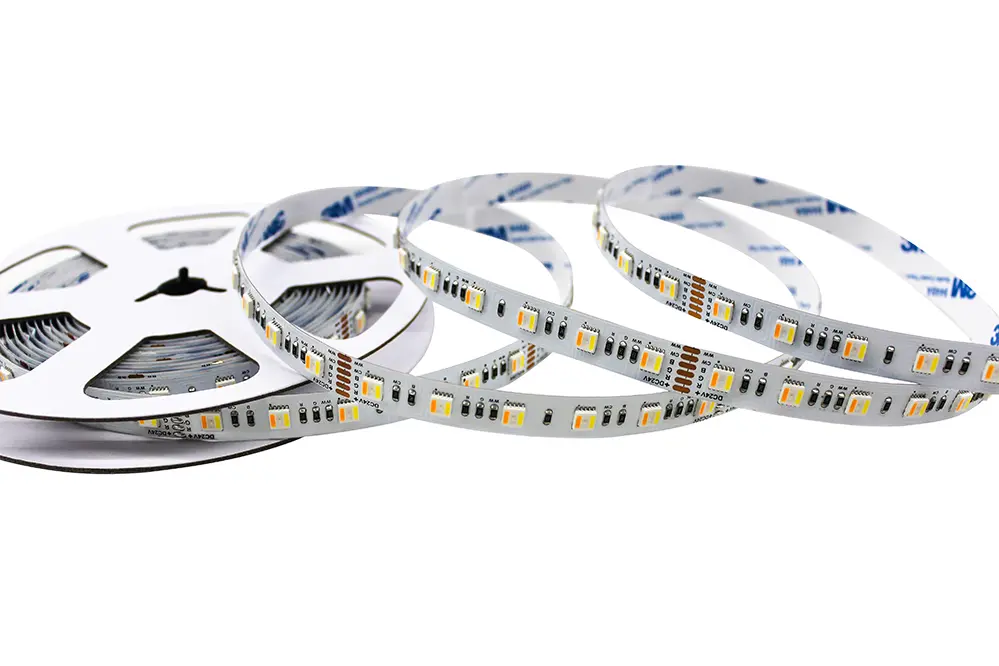
RGBWW LED strip lights, providing the ultimate lighting experience, excel in both versatility and precise color representation.
They distinguish themselves by incorporating both warm white (WW) and cool white diodes into the RGB spectrum, creating an exceptional range of lighting possibilities. This amalgamation results in superior color fidelity, offering more natural and nuanced lighting effects that can transition seamlessly between vibrant colors and precise white light.
By combining RGB and dual-white capabilities, RGBWW LED strip lights unlock unparalleled flexibility. They cater to various lighting requirements, whether one desires a vivid, dynamic display or a serene, warm ambiance that mimics natural light.
These strips are especially advantageous for projects demanding varied lighting conditions. From enhancing home aesthetics to professional settings, RGBWW LED strip lights optimize the visual appeal and functionality of any space, blending advanced technology with aesthetic excellence.
Why Choose RGBWW Strips?
RGBWW strips offer unmatched versatility, combining vibrant RGB colors with warm and cool white light.
This combination makes them an excellent choice for ambient lighting, task lighting, and decorative purposes, where both precise color representation and the option to adjust color temperature are essential. RGBWW strips thus provide enhanced lighting quality that suits various applications, from creating a lively atmosphere to offering a cozy, relaxing environment.
Additionally, RGBWW strips create a lighting experience that is closer to natural sunlight. Their ability to simultaneously offer dynamic, colorful effects and soft, adjustable white light makes them ideal for spaces requiring adaptive lighting solutions.
In summary, RGBWW LED strips stand out for their exceptional lighting flexibility, providing varied color temperatures and vibrant color options. This makes them perfect for a wide range of applications, from residential homes to sophisticated commercial settings, ensuring both functional efficiency and aesthetic brilliance.
Understanding RGBW vs RGBWW
To understand RGBW vs RGBWW, one must first grasp the fundamental differences and unique advantages they each provide.
RGBW, or Red, Green, Blue, and White, integrates an additional white LED into the standard RGB configuration, offering enhanced brightness and a broader range of color combinations. This additional white light source allows RGBW strips to achieve more accurate and natural whites, ideal for environments where precise white lighting is critical.
Conversely, RGBWW stands for Red, Green, Blue, Warm White, featuring an extra warm white LED. This addition enables RGBWW strips to offer a warm and cozy white light, mimicking the softness of traditional incandescent lighting. Such luminance is often favored in residential settings and spaces that require a more inviting and comforting ambiance.
Both RGBW and RGBWW provide exceptional versatility, yet they cater to slightly different needs. RGBW is perfect for scenarios requiring precise, crisp white lighting, while RGBWW is ideal for creating a warm and relaxed atmosphere. These unique features make them invaluable tools for achieving tailored lighting experiences across diverse environments, from professional spaces to cozy home settings.
What Are RGBCCT LED Strip Lights?
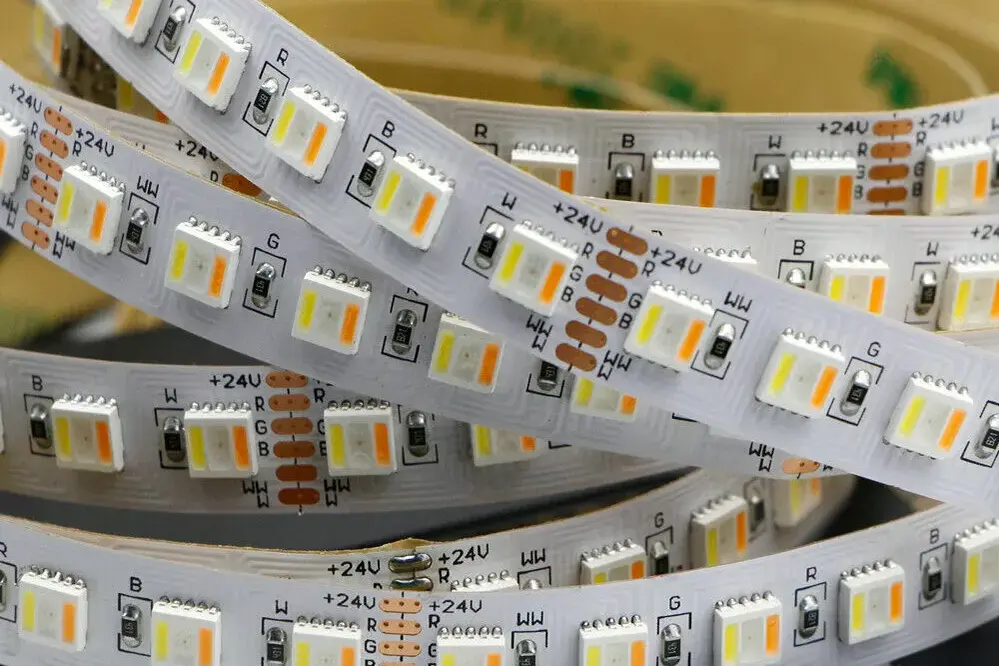
RGBCCT LED strip lights represent the pinnacle of lighting versatility, marrying the best elements of RGB, white, and color temperature control.
They combine RGB LEDs with adjustable dual-white LEDs.
These dual-white LEDs include both warm white and cool white.
Such an arrangement allows for nuanced control over light temperature and color.
Users can finely tune the warmth or coolness of the white light, ensuring spaces are well-lit and inviting.
As a result, RGBCCT strips are ideal for applications demanding both vibrant colors and precise white lighting. Through sophisticated technology, these lights cater to both aesthetic and functional lighting needs.
Benefits of RGBCCT Strips
The primary advantage of RGBCCT strips lies in their remarkable versatility.
This flexibility makes them suitable for various settings.
They seamlessly switch between vibrant RGB colors and precise white tones, enabling users to create atmospheres that match different occasions and moods effortlessly.
Furthermore, their dual-white feature allows for the customization of color temperature, providing a broad spectrum from warm to cool whites. By doing so, professionals and homeowners alike can tailor their lighting to enhance productivity, relaxation, and overall ambiance. This adaptability cements RGBCCT strips as an indispensable addition to any lighting repertoire.
Comparison: RGB vs RGBW vs RGBIC vs RGBWW vs RGBCCT LED Strip Lights
When determining the optimal choice among RGB, RGBW, RGBIC, RGBWW, and RGBCCT LED strip lights, one must consider a few critical factors, including functionality, flexibility, and specific application requirements.
RGB strip lights stand for Red, Green, and Blue, offering a simple yet comprehensive color palette.
RGBW strips add white LEDs to the mix, enabling both colorful and pure white lighting options.
Conversely, RGBIC strips allow for independent color control, making them well-suited for varied and dynamic lighting effects.
Similarly, RGBWW includes warm white LEDs, extending the versatility to create cozier atmospheres, especially valuable in residential settings.
Lastly, RGBCCT strips surpass others with their dual-white capability, offering precise color temperature adjustments that cater to diverse lighting needs from vibrant hues to nuanced whites.
Ultimately, the right selection depends on one’s specific lighting objectives, whether aesthetic vibrancy, functional illumination, or a blend of both is paramount.
How to Choose the Right LED Strip Light
Selecting the perfect LED strip light.
For the best results, consider the desired ambiance. RGB lights are ideal for those seeking vibrant, colorful lighting for entertainment or decorative purposes. Meanwhile, RGBW and RGBWW provide a more versatile approach by including pure white or warm white options, accommodating varied lighting scenarios.
Evaluate color control flexibility.
While RGBIC offers dynamic, independent color control fitting for complex lighting designs – think about how critical this feature is for specific projects – their extra functionality may come at a premium cost.
Think about the optimal solution for one’s needs.
Comparison of the unique advantages of RGBW, RGBIC, RGBWW, and RGBCCT helps ensure a tailored choice, delivering efficacy and satisfaction in lighting endeavors. Each type’s distinct capabilities lend themselves to different applications, so thorough understanding leads to optimal decisions.
Installation Tips for LED Strip Lights
Choose an appropriate power source.
Ensuring the power supply matches the strip’s voltage is crucial. This not only maintains the longevity of the LED strip lights but also guarantees consistent illumination, reducing risks associated with electrical mishaps. Furthermore, consider the use of a power adapter with sufficient wattage to prevent overloading.
Follow manufacturer guidelines.
Configuration will vary, so refer to the installation manual.
Clean surfaces before installation.
Using a clean, dry surface ensures that the adhesive backing of the LED strip lights adheres properly, reducing the likelihood of them peeling off over time.
Install in well-ventilated areas to minimize heat buildup and prolong the lifespan of the lights. Organizing the installation area methodically also aids in avoiding any unnecessary complications, ensuring a smooth setup process.
By meticulously following these installation guidelines, one can achieve professional-level installations that not only look impressive but also function optimally. This proactive approach guarantees longevity and efficiency in illuminating spaces, making the entire endeavor both rewarding and visually stunning.
FAQ on LED Strip Light Options
What is the difference between RGBW and RGBWW vs RGBCW?
RGBW, RGBWW, and RGBCW LED strip lights are ingenious solutions in the world of lighting, each offering distinct features. They expand on the basics of RGB lighting, adding white light for enhanced color mixing and brightness.
RGBW includes separate red, green, blue, and white LED chips in one strip. This configuration provides vibrant, full-spectrum color and a pure white light.
On the other hand, RGBWW features both warm white and cool white LEDs, perfect for achieving natural lighting hues. It simulates daylight more accurately, which is essential for creating inviting atmospheres.
Likewise, RGBCW includes both RGB capabilities and cool white LEDs. It is ideal for environments where clean, crisp lighting is required, such as workspaces.
The added white LEDs in these strips enhance their versatility and range, making tailored lighting schemes possible. Whether it’s for residential, commercial, or creative spaces, these solutions deliver.
As LED technology advances, users can enjoy greater customization and efficiency. This evolution offers endless possibilities for lighting innovations and applications.
Is RGB or RGBIC better?
RGBIC and RGB each illuminate their environments with vibrant, colorful splendor.
RGBIC technology, renowned for its addressable LEDs, offers an unparalleled level of customization and control. Users relish in the ability to program different sections of the strip to display unique colors simultaneously, elevating ambience to extraordinary heights. This feature proves especially beneficial for intricate lighting designs where color diversity and dynamic transitions are paramount.
Contrastingly, RGB lighting, while less complex, still delivers impressive vividness and versatility. Users can achieve a wide array of colors by combining red, green, and blue lights. This simplicity can be advantageous for those seeking straightforward, cohesive lighting without the need for individual LED control.
Ultimately, the decision hinges on the specific needs and preferences of the user. RGBIC is ideal for those desiring advanced lighting scenarios and intricate designs, while RGB serves well for users seeking bright, impactful lighting with fewer customization requirements. Both technologies hold immense potential to transform spaces, each contributing in their unique way to enhancing visual experiences.
What is the difference between CCT and RGBCCT?
CCT represents Correlated Color Temperature, which measures the color appearance of light emitted by a source. It ranges from warm (yellowish) tones to cool (bluish) tones.
On the other hand, RGBCCT integrates not only RGB (Red, Green, Blue) capabilities but also the full spectrum of adjustable white light, from warm to cool hues. This dual-functionality allows for enhanced lighting versatility, making it an exceptional choice for varied applications.
By blending RGB color-changing abilities with the nuanced adjustments of CCT, RGBCCT provides unrivaled flexibility. Users can create both vibrant and subtly adjusted environments, catering to different moods and functions seamlessly.
Therefore, the RGBCCT’s wider spectrum of lighting options stands out. It ensures spaces are not only beautifully lit but also optimally adapted to different circumstances, offering both aesthetic appeal and functional lighting solutions.
Should I get RGB or RGBW?
Opting between these two choices depends on one’s needs.
RGB LED strip lights excel in delivering vivid colors. They are perfect for creating dynamic atmospheres in various settings, from celebrations to enhancing home decor. With RGB, an individual can choose from millions of color combinations to suit their preferences.
On the other hand, RGBW adds a white LED.
This inclusion enhances versatility. It allows not only vibrant colors like RGB but also a pure white light for more refined lighting requirements. RGBW lights, therefore, offer the best of both worlds, making them suitable for both decorative and functional purposes.
Their decision ultimately hinges on their desired application. If the goal is simply to introduce a spectrum of colors, then RGB is an economical and effective solution. However, if there is a need for both vibrant colors and practical white lighting, investing in RGBW LED strips will provide greater satisfaction and utility.
When to use RGBCCT LED strip lights?
RGBCCT LED strip lights excel in environments where adaptable lighting is a priority. They render both RGB colors and a wide range of white light temperatures, making them versatile.
Homeowners may find these lights perfect for creating various mood settings. For instance, a cooler white light caters to task lighting, whereas a warmer hue generates a cozy, inviting atmosphere for relaxation.
In retail or commercial settings, these strips enhance visual merchandising. The ability to change colors or adjust the white light temperature can highlight products effectively, influencing customer experience and purchase behavior.
Moreover, event planners utilize RGBCCT LEDs for their dynamic capabilities. Whether it’s a corporate event requiring a professional ambiance or a celebratory party needing vibrant lighting, these lights adapt seamlessly to any theme or occasion.
They offer a unique blend of functionality and aesthetic appeal. This makes them a top choice for both residential and professional lighting solutions, exceeding the capabilities of more basic LEDs.
Do RGBIC LED strip lights have warm white?
RGBIC LED strip lights, unlike their RGB and RGBW counterparts, are designed to offer a vibrant array of colors through the use of individually addressable LEDs. Each LED segment can be controlled independently, creating a dynamic and multi-colored display that delights the senses and enhances the ambiance of any space.
However, when it comes to producing a warm white light, RGBIC strips face limitations.
The inherent design focuses on color diversity and visual effects. While RGBW or RGBCCT strips integrate dedicated white LEDs, RGBIC strips rely on a blend of red, green, and blue to approximate various tones, including white.
Thus, they do not include a dedicated warm white LED.
Instead, they simulate warm white by mixing the primary colors, often resulting in a cooler white hue that lacks the softness of true warm white light.
For projects requiring accurate warm white light in combination with vibrant colors, alternative LED types, such as RGBW or RGBCCT, might be more suitable. With these alternatives, users can enjoy the full spectrum of colors alongside a true warm white, achieving a balanced and versatile lighting solution.
How does RGBWW differ from RGBCCT?
RGBWW and RGBCCT are fundamentally different in their capabilities and applications.
By incorporating warm white and cool white LEDs, RGBWW offers a broader spectrum of lighting options, allowing much smoother transitions and natural white light reproduction. This makes it ideal for creating ambiance that mimics natural light settings.
On the other hand, RGBCCT includes color temperature control (CCT) technology, which allows for fine-tuning the white light between warm and cool tones. This provides a higher degree of control and customization for various lighting needs, from reading to relaxing.
In essence, while both RGBWW and RGBCCT elevate standard RGB lighting, the choice between them hinges on whether one values natural white light or precise control over color temperature. Their unique features make them each a powerful tool for sophisticated lighting solutions, catering to varied aesthetic and functional preferences.
Conclusion
In summary, the array of available LED strip lights offers something for everyone’s unique needs and preferences.
When comparing RGB vs RGBW vs RGBIC vs RGBWW vs RGBCCT LED strip lights, it becomes evident that each variety provides distinct benefits, making them ideal for different applications. RGB lights cater to those seeking vibrant color displays, while RGBW offers a mix of both colors and true white light, broadening its functional applications.
RGBIC, on the other hand, is for those desiring intricate lighting patterns within a single strip, perfect for dynamic and visually engaging environments. Meanwhile, RGBWW and RGBCCT include added capabilities, such as warm white light and adjustable color temperatures, respectively, offering even more versatility in lighting design.
Overall, the selection process will greatly depend on the specific lighting goals at hand. By leveraging the unique strengths of each type, one can create sophisticated, professional, and inspiring lighting setups that not only meet but exceed expectations, regardless of the project scale or setting.
As you consider your options for LED strip lights, it’s essential to partner with a reliable and experienced manufacturer. Unitop, a professional Chinese manufacturer of LED strip lights and LED neon strips, stands out as a trusted name in the industry. With their commitment to quality and innovation, Unitop offers a wide range of products designed to meet diverse lighting needs. Whether you’re a lighting enthusiast or a professional, reaching out to Unitop can provide you with the expertise and high-quality products necessary to bring your lighting projects to life. Don’t hesitate to contact Unitop for all your LED strip lighting needs and experience the difference that professional craftsmanship can make.
